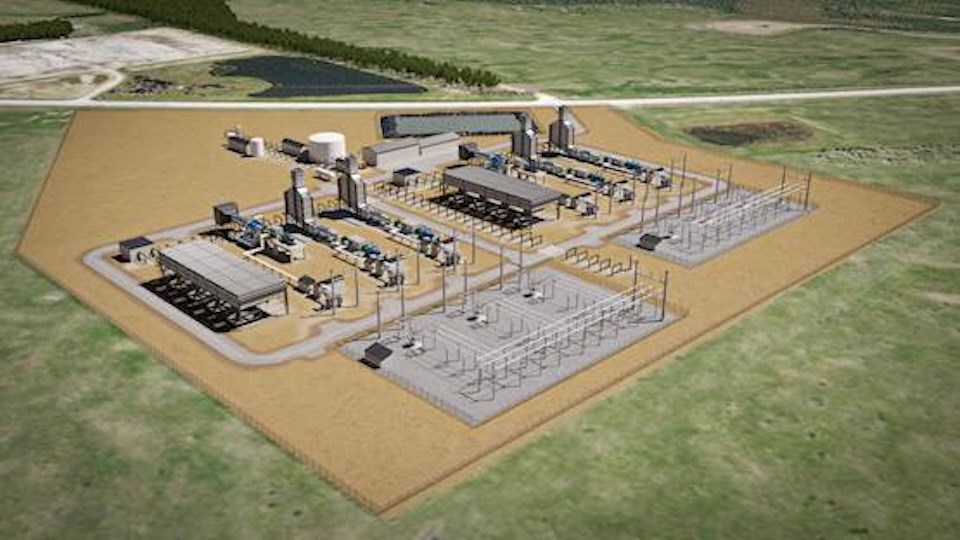LAKELAND - The province is investing $5 million in the Marguerite Lake Compressed Air Energy Storage Project north of La Corey, to facilitate studies and pre-construction activities as Cache Power Corp. continues to work towards a final investment decision.
Once built, the project will use excess energy from renewables to store compressed air in underground salt caverns, which will then be heated and released through turbines to generate electricity during peak hours. Phase One will add 320 megawatts to the Alberta energy grid.
According to Jordan Costley, the president of Cache Power Corp, which is owned by Federation Group Inc. where he is also a director, the grant from Emissions Reduction Alberta will finance a study to come to commercial terms with Siemens Energy, the company providing the compression and expansion trains.
“We’ll drill a well and retrieve our salt cores to do geomechanical testing that’s required to get our AER [Alberta Energy Regulator] solution mining schemes,” said Costley.
The funding was announced alongside $3.9 million for LithiumBank Resources to extract lithium from underground brine aquifers in northern Alberta, and $3.8 million for Carbon Management Canada to test a new monitoring system for underground carbon dioxide sequestration.
“These three projects will help tap into the massive potential of Alberta’s unique underground resources. By helping support these new technologies, we are showing how our unique geology can help grow the energy sector, strengthen the grid and create more high-paying jobs for Albertans for decades to come,” said Rebecca Schulz, Minister of Environment and Protected Areas.
Costley said they also received $2 million in May from Alberta Innovates for the hydrogen component planned for the second phase of the Marguerite Lake project.
According to the project summary from Alberta Innovates, it will produce 60 tonnes of hydrogen per day and integrate with the CAES facility for net-zero power generation, as well as “validate the technical and economic feasibility of large-scale hydrogen production, storage, and utilization.”
Costley said the Phase Two expansion was planned from the beginning, so the Phase One footprint was developed to incorporate the hydrogen aspects.
“The two grants we received . . . were the maximum amounts that could be received out of those programs. So, it’s an indication of how much support the Government of Alberta has provided and very exciting for our project partners,” said Costley.
He also highlighted the support from Bonnyville-Cold Lake-St. Paul MLA Scott Cyr, who he described as “instrumental in setting up meetings with various ministers and their ministries so we could highlight our exciting project and the benefits it will have to all Albertans.”
In an e-mailed statement, Cyr called the Marguerite Lake project an important milestone for both the Lakeland region and the province.
“It’s incredibly rewarding to see it reach this stage. This investment aligns perfectly with my long-standing belief that we must pursue every available investment and grant opportunity to drive local jobs, innovation, and economic growth in our region,” said Cyr.
“If this project proceeds to full deployment, it will represent at least a $500 million investment and bring significant employment opportunities to the MD of Bonnyville,” said Cyr.
According to Costley, the Marguerite Lake project has now received all the major regulatory approvals, including from the Alberta Utilities Commission (AUC), under the Environmental Protection and Enhancement Act (EPEA), and development permits from the M.D. of Bonnyville.
Costley said they plan to wait until the end of the grazing season to begin work on the site, which is 16 kilometres north of La Corey, within the Wolf Lake Provincial Grazing Reserve.
“With the drought in the area, that’s already affecting a lot of farmers and ranchers, we definitely did not want to remove any grazing areas, so we will wait until the cattle are out,” said Costley.
He said while they are still having funding discussions including with the Canada Infrastructure Bank and through their partners at Cold Lake First Nation, “the time continues to be right to advance this project.”



